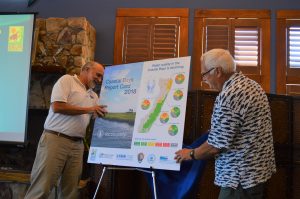
WEST OCEAN CITY – Citing a lack of data, officials this week announced Maryland’s coastal bays received an incomplete health rating in 2018, but highlighted a decline in water quality.
For the first time since 2008, the coastal bays system last year received an “incomplete” grade on its annual Coastal Bays Report Card.
Each year, the Maryland Coastal Bays Program (MCBP), University of Maryland Center for Environmental Science (UMCES), the Maryland Department of Natural Resources (DNR) and its partnering agencies release a report on the health of Maryland’s coastal bays by measuring four water quality indicators – nitrogen, phosphorous, chlorophyll and dissolved oxygen – and two biotic indicators – seagrass and hard clams – in six regions of the coastal bays and issuing a grade.
“The report card has been an annual snapshot of how well the bays’ health is and we created it in 2008,” said MCBP Executive Director Frank Piorko. “Over the years, the overall grade of the bays has been consistent with a C-plus, except for last year in our 2017 report card, which was the first year we reached a B-minus.”
This week, however, officials with the partnering agencies explained they were unable to complete the report card for 2018 because weather events and issues with boat availability had prevented them from collecting data on seagrass and hard clams.
“We are missing some of the grades for some of the key parameters that we have used for the report card in the past several years that we’ve been doing this,” said DNR Environmental Program Manager Cathy Wazniak. “We did not get data for seagrasses or hard clams this past year. That is why the report card has an incomplete. That data is really critical, so we are still working to make sure we continue those monitoring programs.”
Bill Dennison, vice president for science applications at UMCES, explained that the partnering agencies use aerial imagery and boats to monitor seagrass and hard clams in the coastal bays.
“We never had a weather window with low tide, lack of wind and no cloud cover …,” he said. “We couldn’t obtain the data.”
Despite the setback, officials continued to monitor water quality indicators in the Assawoman, Chincoteague, Isle of Wight, Newport and Sinepuxent bays and the St. Martin River.
“It was a bad year for science, and it was a bad year for the bays,” Dennison said.
Overall, the coastal bays received a score of 71% for water quality, according to the 2018 report card. Water quality scores declined in all segments except Sinepuxent Bay and Newport Bay.
“Newport Bay saw slight improvements in nutrients and algae,” Wazniak said, “and Sinepuxent saw improvements in total phosphorous.”
Officials noted that warmer temperatures and rain events last year contributed to declining water quality in Maryland’s coastal bays.
Dennison said rainfall and coastal flooding washed pollutants from agricultural and urban areas into the coastal bays. He noted that fertilizers, pesticides and flooded septic systems, among other things, contributed to pollutants and bacteria in the groundwater.
“It’s not the rain that’s the problem,” he said. “It’s what’s in the rain that’s carried from the land to the sea that’s the problem.”
For more information, or to view the 2018 Maryland Coastal Bays Report Card, visit ecoreportcard.org.

